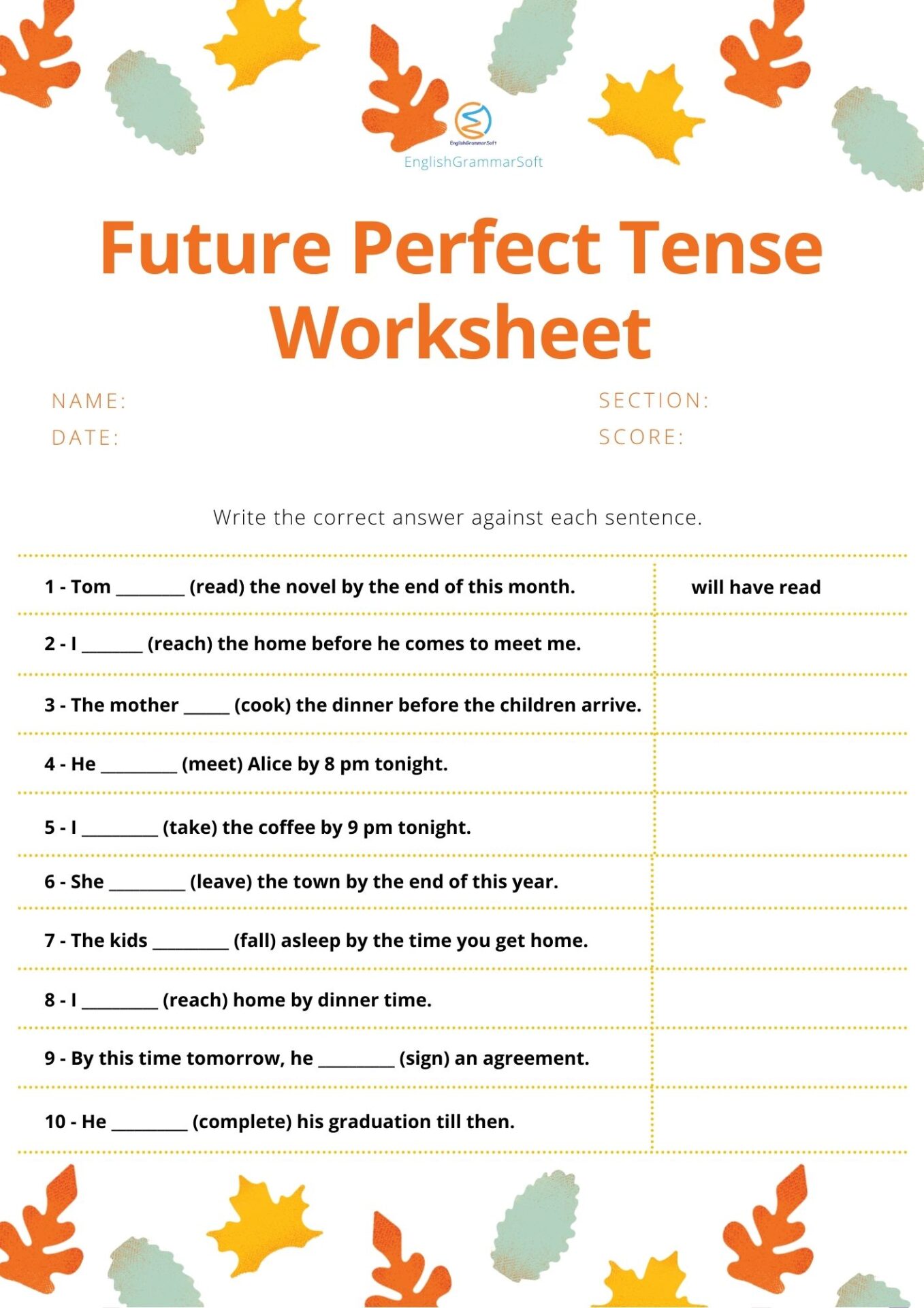
Mastering Tomorrow’s Actions: The Indispensable Role of Future Perfect Worksheets
The English language, with its rich tapestry of tenses, often presents learners with a fascinating yet formidable challenge. Among these, the Future Perfect tense stands out as particularly nuanced, requiring not just an understanding of future events but also a grasp of their completion before a specified point in the future. It’s a tense that speaks to planning, prediction, and the sequencing of events in time yet to come. For educators and learners alike, achieving proficiency in this tense is crucial for sophisticated communication. This is precisely where Future Perfect worksheets emerge as an indispensable tool, providing structured practice, contextual application, and a clear path to mastery.
Understanding the Future Perfect Tense: A Brief Refresher
Before diving into the utility of worksheets, it’s vital to firmly grasp the Future Perfect tense itself. It is formed with "will have" followed by the past participle (V3) of the main verb (e.g., will have finished, will have gone, will have been). Its primary function is to describe an action that will be completed at or before a certain point in the future.
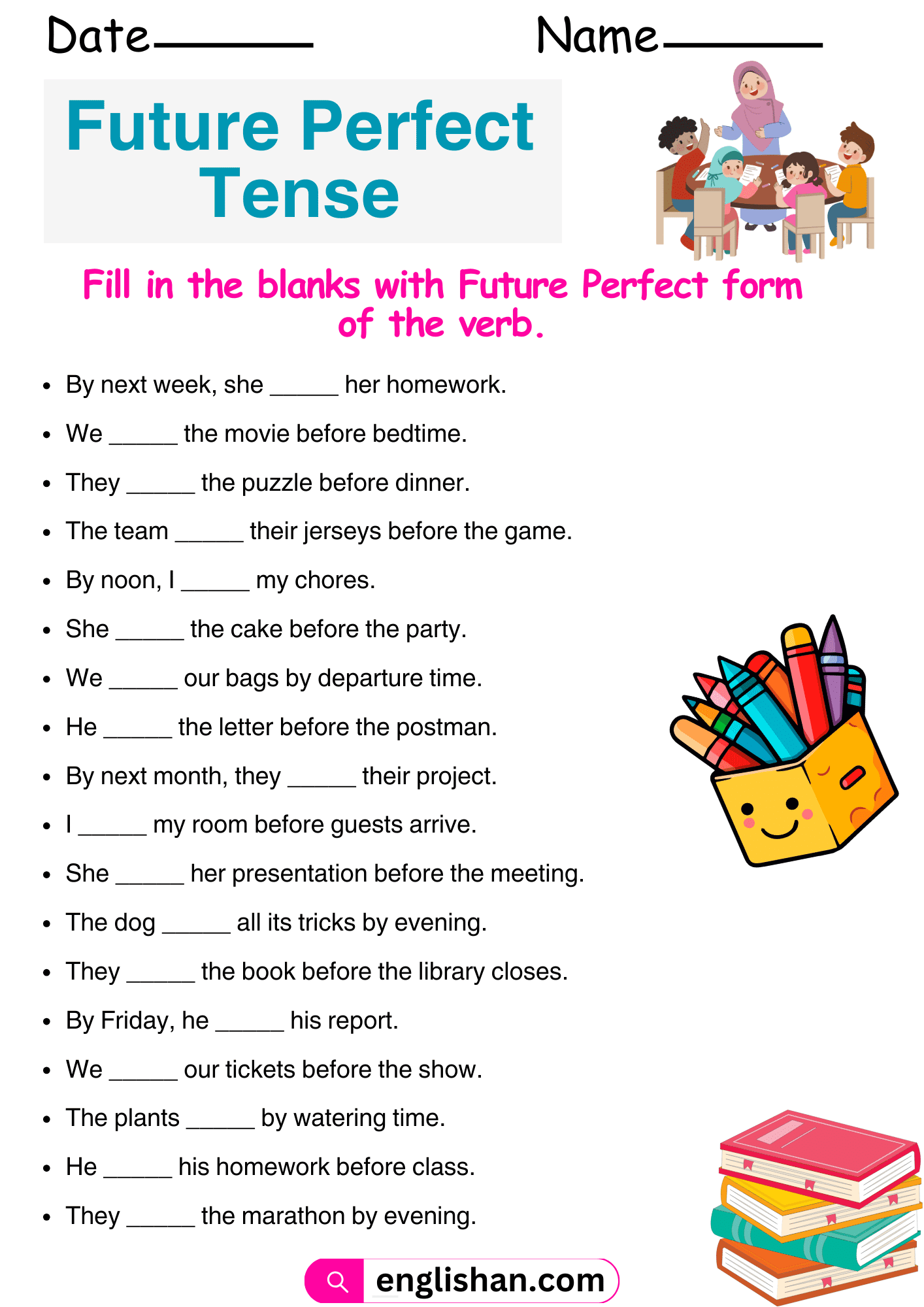
Consider these examples:
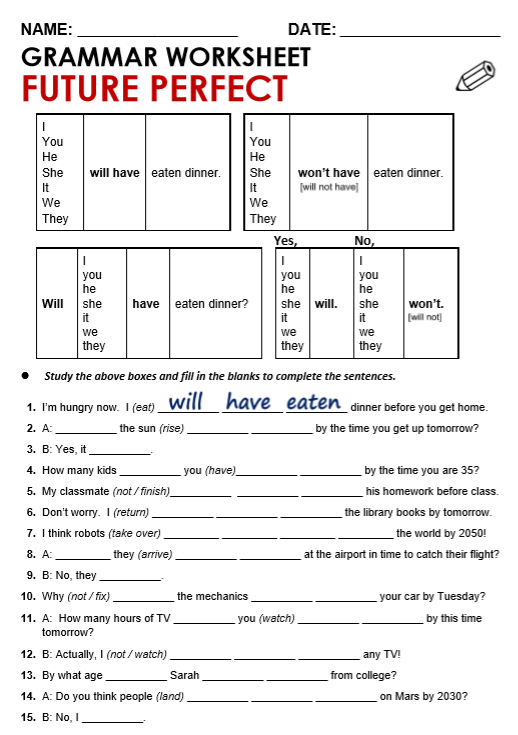
- "By next year, I will have graduated from university." (The graduation is completed before "next year").
- "They will have eaten dinner by the time we arrive." (Eating dinner is completed before "we arrive").
- "In two hours, she will have written the entire report." (Writing is completed within "two hours").


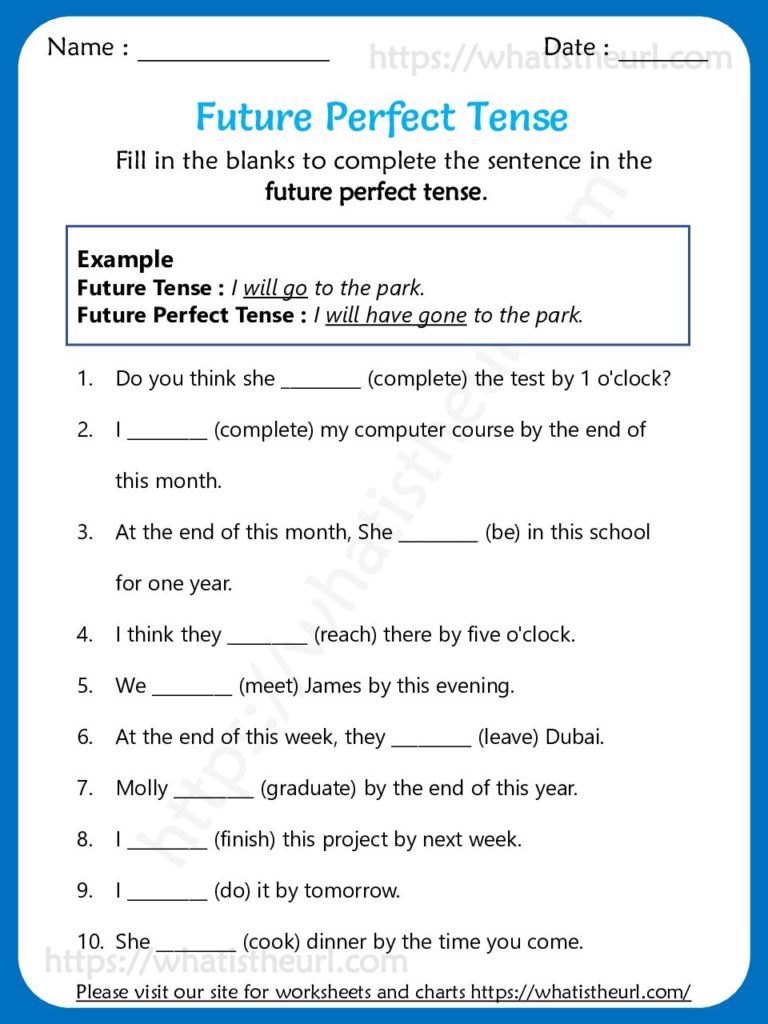
Common time expressions that signal the Future Perfect include "by," "by the time," "before," "until" (in negative sentences), "in [X time]," and "by the end of [period]." The challenge often lies in distinguishing it from the Future Simple (an action that will happen at a future point) and the Future Continuous (an action that will be ongoing at a future point). This subtle distinction underscores the need for targeted and repetitive practice that Future Perfect worksheets can uniquely provide.
Why Worksheets Are Essential for Mastering the Future Perfect
In an educational landscape increasingly dominated by digital tools and interactive platforms, the humble worksheet might sometimes be overlooked. However, for a tense as intricate as the Future Perfect, Future Perfect worksheets offer unparalleled benefits:

- Structured Practice: Worksheets break down the learning process into manageable steps. They provide a scaffold for learners to practice the form (will have + V3) and then apply it in various contexts, moving from simple recognition to complex sentence construction.
- Reinforcement and Repetition: Mastery of any grammatical concept requires repetition. Worksheets allow learners to practice numerous examples, solidifying their understanding through consistent exposure to correct usage and common patterns.
- Identification of Error Patterns: As learners complete exercises, common mistakes (e.g., using "will finish" instead of "will have finished," incorrect past participles) become apparent. This allows both the learner and the educator to pinpoint areas needing more attention.
- Application in Context: Beyond mere conjugation, effective worksheets embed the Future Perfect in meaningful scenarios, helping learners understand when and why to use this specific tense. This moves them beyond rote memorization to true comprehension.
- Self-Assessment and Feedback: Many worksheets come with answer keys, enabling learners to check their work independently. This immediate feedback loop is crucial for self-correction and building confidence.
- Tangible Progress: Completing a physical or digital worksheet provides a sense of accomplishment and a visual representation of progress, which can be highly motivating.


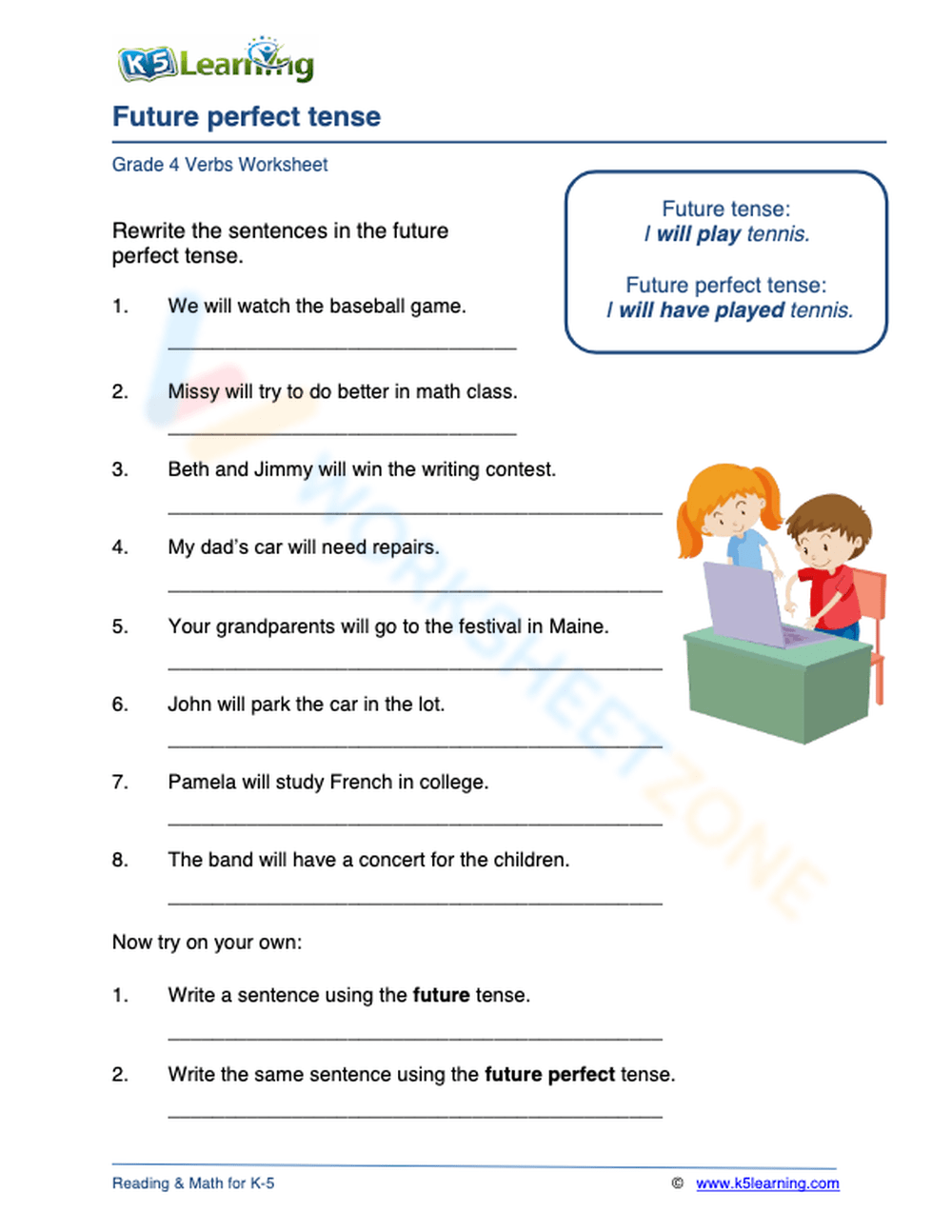
Types of Effective Future Perfect Worksheets
The design and variety of Future Perfect worksheets can significantly impact their effectiveness. A comprehensive approach incorporates multiple exercise types, each targeting a specific aspect of learning:
-
Fill-in-the-Blanks: These are foundational. Learners are given sentences with a blank where the Future Perfect form of a verb needs to be inserted.
- Example: By 2030, humans _____ (land) on Mars. (Answer: will have landed)
- Benefit: Reinforces the correct structure ("will have" + V3) and helps learners identify time markers.
-
Sentence Transformation: Learners are given sentences in another tense (e.g., Future Simple, Present Simple) and asked to rewrite them using the Future Perfect, often adding a future time marker.
- Example: I will finish my project. (Rewrite using Future Perfect by tomorrow evening)
- Transformed: I will have finished my project by tomorrow evening.
- Benefit: Develops flexibility in tense usage and highlights the specific nuance of completion by a future point.
-
Error Correction: Learners are presented with sentences containing grammatical errors related to the Future Perfect and must identify and correct them.
- Example: By next month, she will finish her new book. (Error: will finish -> will have finished)
- Benefit: Enhances critical thinking and deepens understanding of common pitfalls.
-
Matching Exercises: Matching Future Perfect clauses with appropriate future time expressions or matching questions with Future Perfect answers.
- Example: Match the start of the sentence with its ending:
-
- By the time I retire,
-
- She will have traveled around the world
- A. I will have saved enough money.
- B. before she turns thirty.
-
- Benefit: Strengthens the connection between the tense and its typical contextual cues.
- Example: Match the start of the sentence with its ending:
-
Contextualized Scenarios/Short Paragraphs: Learners read a short story or scenario about future events and fill in the blanks or answer questions using the Future Perfect.
- Example: "Imagine you are planning a big party. By 6 PM, what will have happened? By the time guests arrive, what will you have done?"
- Benefit: Encourages natural application of the tense in realistic situations, promoting deeper understanding of its function.
-
Creative Writing Prompts: Learners are given a future scenario and asked to write a short paragraph or set of sentences using the Future Perfect.
- Example: "Describe what your life will be like in 10 years. What will you have achieved? Where will you have traveled?"
- Benefit: Fosters independent production and allows learners to integrate the tense into their own expression.
-
Dialogue Completion/Role-Playing: Worksheets can present incomplete dialogues where learners must use the Future Perfect to respond or ask questions.
- Example:
- A: Do you think you’ll have finished your work by lunchtime?
- B: Yes, I ____ by 12 PM.
- Benefit: Simulates real-life communication and helps learners internalize the conversational use of the tense.
- Example:
Designing Effective Future Perfect Worksheets: Best Practices
Creating high-quality Future Perfect worksheets requires careful thought and pedagogical insight:
- Clear Instructions: Ambiguity frustrates learners. Instructions should be concise, unambiguous, and perhaps include an example.
- Varied Difficulty Levels: Start with simpler exercises and gradually increase complexity. This caters to different learning paces and builds confidence.
- Contextual Relevance: Use scenarios that are relatable and engaging to the target audience. Topics like travel, future careers, environmental changes, or personal milestones work well.
- Gradual Progression: Introduce new concepts incrementally. Don’t overwhelm learners with too many new rules or irregular verbs at once.
- Inclusion of Answer Keys: Essential for self-correction and for teachers to quickly check understanding.
- Visually Appealing Layout: A clean, uncluttered design with appropriate spacing and clear fonts enhances readability and reduces cognitive load.
- Focus on Common Errors: Design exercises that specifically target typical mistakes learners make with the Future Perfect.
- Integration with Other Skills: While primarily grammar-focused, worksheets can also incorporate vocabulary, reading comprehension, or even speaking (if used as a basis for discussion).
Integrating Worksheets into Lesson Plans
Worksheets are not isolated activities but integral components of a well-rounded lesson plan. They can be used at various stages:
- Pre-teaching: As a diagnostic tool to gauge prior knowledge.
- Guided Practice: After an initial explanation, learners complete exercises with teacher guidance, allowing for immediate clarification of doubts.
- Independent Practice: For homework or in-class individual work, consolidating learning.
- Review and Assessment: As a quick check for understanding or as part of a formal assessment.
- Differentiation: Simpler worksheets for struggling learners, more complex or creative tasks for advanced students.
By strategically incorporating Future Perfect worksheets, educators can ensure that learners move beyond superficial understanding to genuine fluency in this critical tense.
Overcoming Common Challenges with Future Perfect Through Worksheets
The Future Perfect often poses specific hurdles for learners:
- Confusion with Future Simple/Continuous: Worksheets with comparative exercises (e.g., "Choose the best tense: will finish / will be finishing / will have finished") force learners to think critically about the timing and completion aspect.
- Identifying the "Future Point": Many learners struggle to recognize the specific future time marker that necessitates the Future Perfect. Worksheets that highlight or require learners to identify these markers (e.g., "Underline the time expression that tells you to use Future Perfect") can be very helpful.
- Irregular Past Participles: The V3 form of irregular verbs is a common stumbling block. Dedicated sections within Future Perfect worksheets that focus on practicing these irregular forms (e.g., lists to complete, sentences requiring specific irregular verbs) are crucial.
- Lack of Natural Usage: Because it’s less common than Future Simple, learners might feel awkward using it. Contextualized worksheets and creative writing prompts encourage more natural production.
The Role of Technology and Interactive Future Perfect Worksheets
While traditional printouts remain valuable, the digital age has brought new dimensions to Future Perfect worksheets:
- Online Platforms: Websites and apps offer interactive exercises with instant feedback, allowing learners to track their progress automatically.
- Gamification: Turning exercises into games can boost engagement and motivation, making learning enjoyable.
- Multimedia Integration: Digital worksheets can embed audio (for listening comprehension or pronunciation) or video clips (to set context).
- Adaptive Learning: Some platforms can adjust the difficulty of exercises based on a learner’s performance, providing a truly personalized learning experience.
- Accessibility: Digital worksheets can be easily shared, accessed on various devices, and often have features for learners with special needs.
Whether digital or print, the core pedagogical value of the worksheet remains: a structured environment for focused practice.
Conclusion
The Future Perfect tense, with its unique ability to describe actions completed before a future point, is a hallmark of advanced English proficiency. Its mastery is not achieved through mere memorization but through consistent, targeted practice. Future Perfect worksheets, in their various forms and applications, provide the essential framework for this learning journey. From reinforcing the basic structure to enabling contextual application and overcoming common difficulties, these worksheets are invaluable resources for both educators crafting comprehensive lessons and learners striving for grammatical accuracy and communicative fluency. By thoughtfully integrating well-designed Future Perfect worksheets into their learning routines, individuals can confidently navigate the complexities of future time, predicting and planning with precision and clarity.
